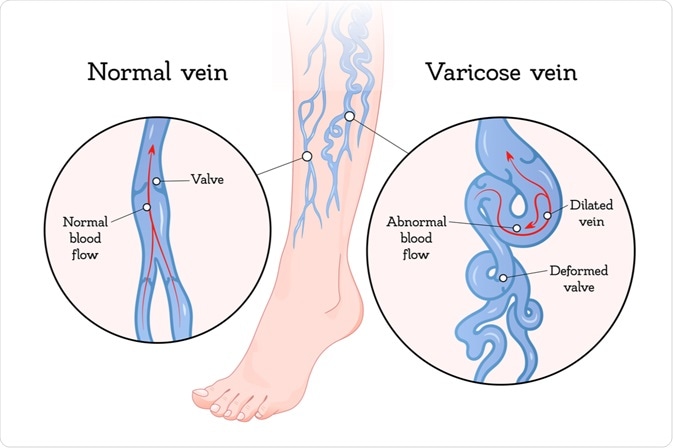Varicose veins are a manifestation of venous insufficiency.

Image Credit: VikiVector / Shutterstock.com
What are varicose veins?
The function of a vein is to return blood to the heart from a peripheral part of the body. The blood in the veins is pushed forwards by the force of the pumped blood in the arteries.
Veins have one-way valves that are designed to close against the backflow of blood. Since veins are thin-walled, this mechanism is essential in order to prevent the pooling of blood in the lower part of every vein.
When these valves are damaged by infection, or disease, or as the result of too much and prolonged pressure on them, blood leaks back through them. This causes blood to collect in the part of the vein that is below the valve.
As the blood collects, the vein distends and grows larger and more tortuous. Venous enlargement is a result of the abnormal release of growth factors from the damaged vein walls. This is the origin of varicosity in a vein.
The thin vein walls indicate that when blood pools within them, they stretch unduly. This causes the flaps of the valves to pull apart, causing even normal valves to become incompetent, or leaky. The blood thus moves backward through the valves, pooling in the distal segment of the affected vein.
Part 2: What are Varicose Veins: Diagnosis and Treatment of Varicose Veins
Risk factors
Many factors increase the risk of developing varicose veins. These include:
- Increasing age, which is associated with weakening of the venous wall as a result of collagen breakdown and slower collagen synthesis.
- Obesity, which puts increased pressure on the leg valves, by making it more difficult for blood to move upwards through the veins.
- Repeated pregnancies, because the weight of the enlarged uterus presses down on the large iliac veins into which the leg veins drain, resulting in poor drainage from the leg. In addition, the blood volume increases dramatically during pregnancy. Female hormones also relax the wall of the veins.
- Congenitally weak veins, which has a familial association.
- Prolonged standing, as is required in some occupations, puts more strain on the venous valves
- Lack of leg movement causes the leg veins to become distended with blood, because of the lack of the pumping effect of the calf muscles surrounding the deep leg veins. This produces varicosities in due course. It is still worse if the legs are crossed or bent, since the kinking of the veins puts further pressure on the valves.
- Hormonal changes, as in pregnancy and menopause, or with the use of hormonal pills, cause corresponding changes in the collagen content of the venous wall, encouraging the appearance of varicose veins. Female hormones tend to relax venous walls, making them more prone to the pooling of blood.
- Traumatic injury, or previous blood clots, can cause valve damage as they heal, leading to venous insufficiency.
- Pelvic tumors or cysts also put increased pressure on the iliac veins draining the lower limbs.
References
Further Reading